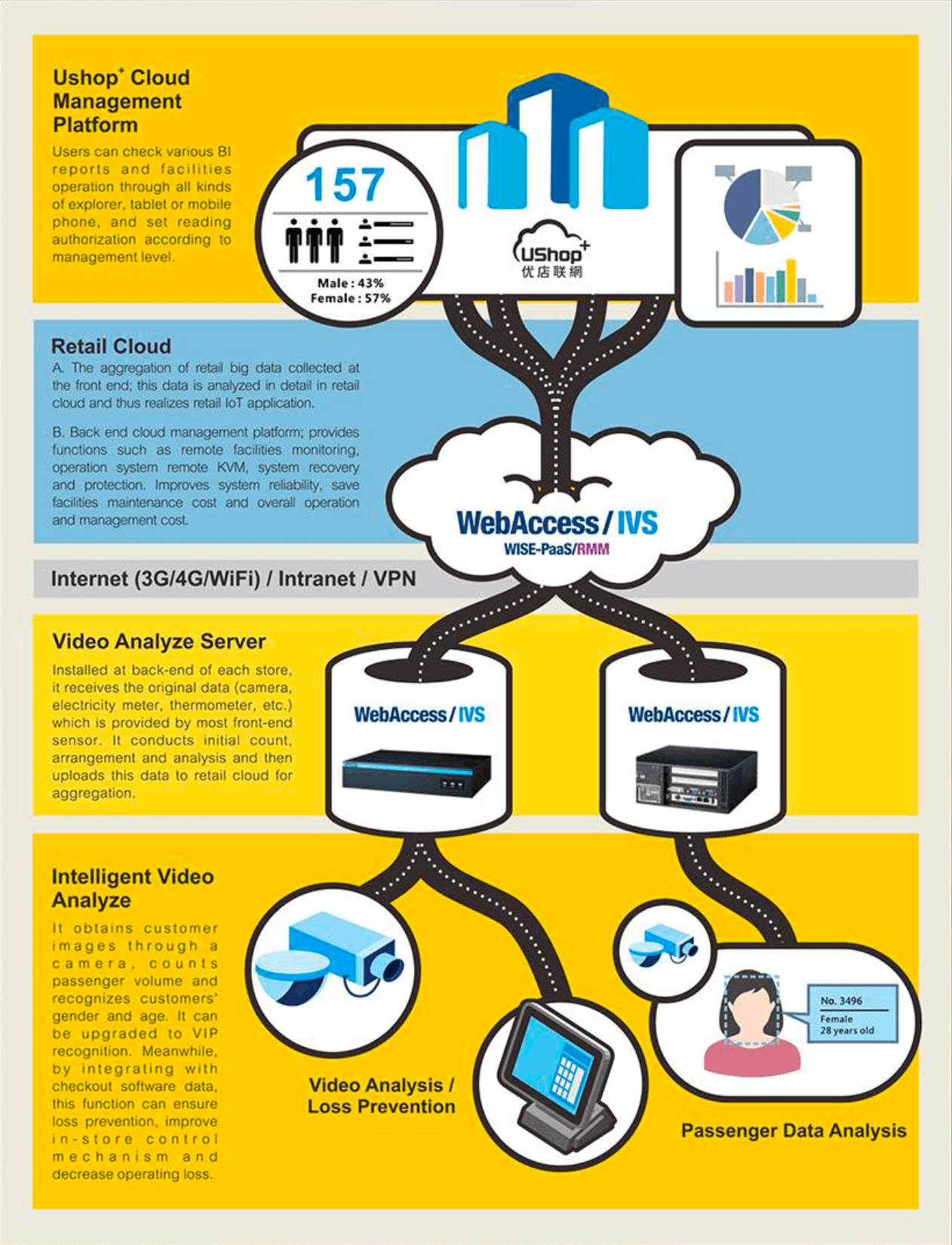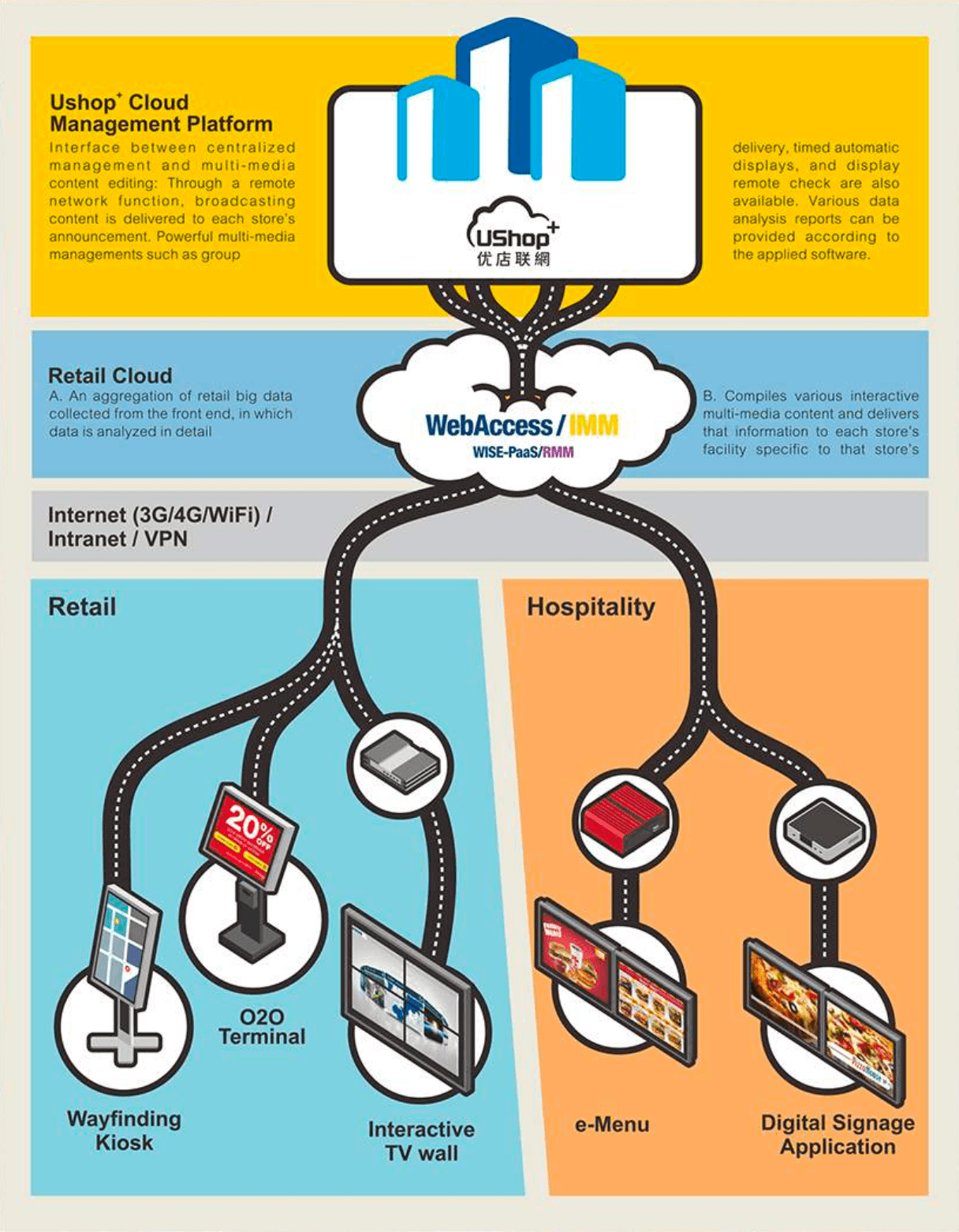Understanding Customers with Intelligent Retail Technology
Retailers want to understand their customers. But customer research can be time-consuming, expensive, and error-prone.
Intelligent retail technology can go a long way toward resolving this dilemma. By combining data from video analytics, self-service systems, and point-of-sale terminals, retailers can gain deep insights into their customers. The result is increased sales, greater operating efficiency, and a more compelling and consistent shopping experience across all sales channels.
To make these insights possible, solutions like the UShop intelligent retail platform from Advantech (Figure 1) bring together everything retailers need to maximize the customer experience—from sensors to cloud-based analytics. Here’s what you need to know about these systems.

Capturing Customer Behavior Data
Video analytics are the foundation of intelligent retail. Cameras placed throughout a retail environment can provide a wealth of information about customer demographics and behavior.
For example, a customer’s gender and age can be assessed upon entry into the store. The system can then track the customer’s journey through the store, identifying when a customer picks up a product, how long the product was examined, and whether the product was put in the cart or back on the shelf.
Retailers can use data like this to understand their customer demographics, when and where different demographics shop, and which items they purchase. Armed with this knowledge, retailers can customize their operations to match demand.
By automating such analysis, retailers can eliminate costly manual retail audience research. Plus, they can get up-to-the-minute reporting on in-store dynamics. Since data is captured continuously, the effectiveness of retail strategies can be evaluated and adjusted in real time.
Uncovering Trends Through Analytics
For even greater value, data can be aggregated in the cloud. Here, retailers can use analytics to monitor, identify, and track shopping trends and behaviors. For example, the effectiveness of product planograms or advertising campaigns can be associated with specific demographics.
Managers can also assess the ways customers move through their stores and build heat maps to assess traffic patterns. Knowing hot spots in the store can help managers understand which products engage customers the longest.
Customer information can also be used to improve day-to-day operational efficiency in a myriad of ways. For example, managers can determine when a store is the busiest, allocate staff more effectively, and tie in the HVAC system to adjust to customer density. Customer and employee tracking enables advanced loss prevention and can speed resolution of checkout disputes.
Big Data also helps retailers uncover larger trends across time and across locations. For example, retailers can identify seasonal trends or where different demographics like to shop.
Delivering Retail Intelligence
Delivering all these capabilities is a tall order. That’s why end-to-end solutions like the UShop intelligent retail platform are so valuable.
The UShop platform starts with a complete ecosystem of equipment from Advantech and its partners, including cameras, sensors, touch displays, POS, panel PCs, and servers. Interconnecting the store environment is the WISE-PaaS remote monitoring and management layer. WISE-PaaS serves both as the in-store infrastructure and links the store to the cloud. Figure 2 illustrates how all the pieces connect in a signage system.

UShop+ for Retail is a complete retail applications suite that runs on top of the WISE-PaaS architecture. UShop+ gives retailers access to data and analytics, enabling them to centralize and remotely manage the entire intelligent retail platform, implement big data and business intelligence, optimize decisions, and increase customer engagement.
Digital Signage Case Study
One of the powerful ways intelligent retail can increase customer engagement and impact sales is by customizing the in-store experience. Digital signage typifies the advantages of customization.
Standard digital signage conveys the same messages to every customer. This means the messages are either generic—and thus of limited effectiveness—or targeted at specific demographics—and thus are wasted on every customer who is not part of those demographics.
When signage is linked to vision systems, messaging can be matched to each customer’s demographic and behaviors. A teenage girl might see a special on lipstick, while a grandmother with her grandson might see a sign for the latest superhero toy.
Content can also be dynamically generated for an even more compelling experience. For example, a display a customer is near might offer a special, time-limited discount on a product that was just being considered but put back on the shelf. This offer can then follow the customer to the POS device.
Custom Experiences
Next-generation intelligent retail technology is the future of in-store and virtual shopping. With platforms like UShop from Advantech and advanced processors from Intel, retailers can leverage multiple technologies – real-time data capture, advanced video analytics, big data analysis, and applications in the cloud – to customize the customer experience, achieve greater operational efficiency, and increase sales.